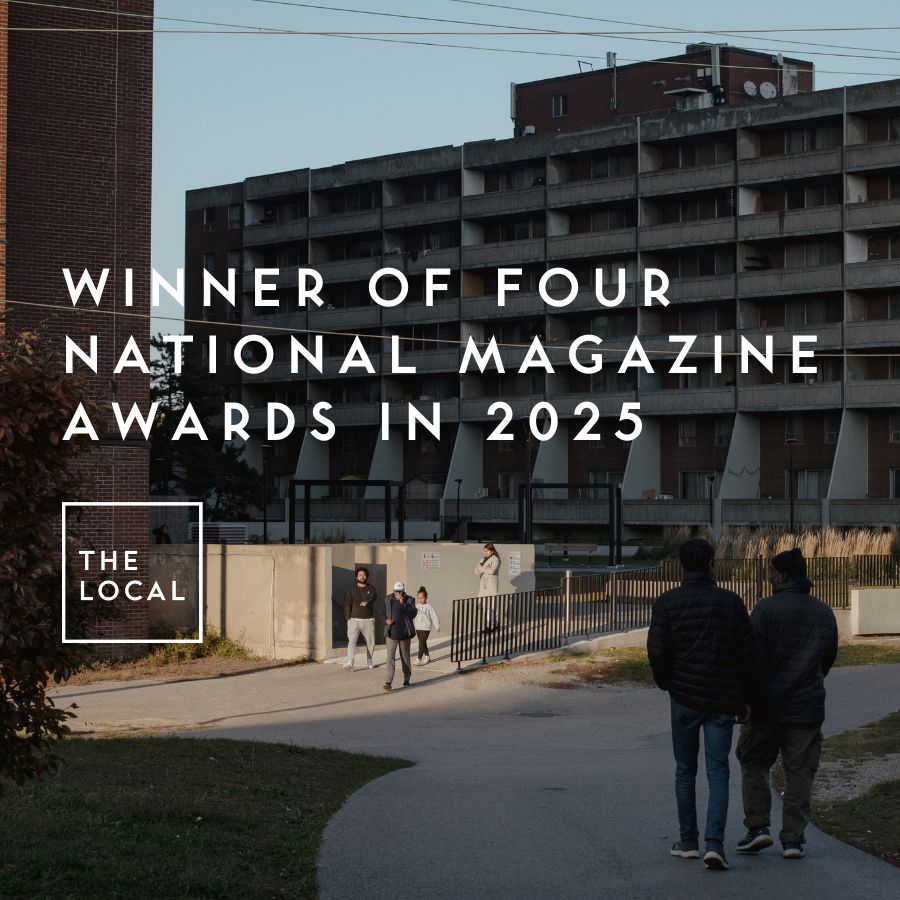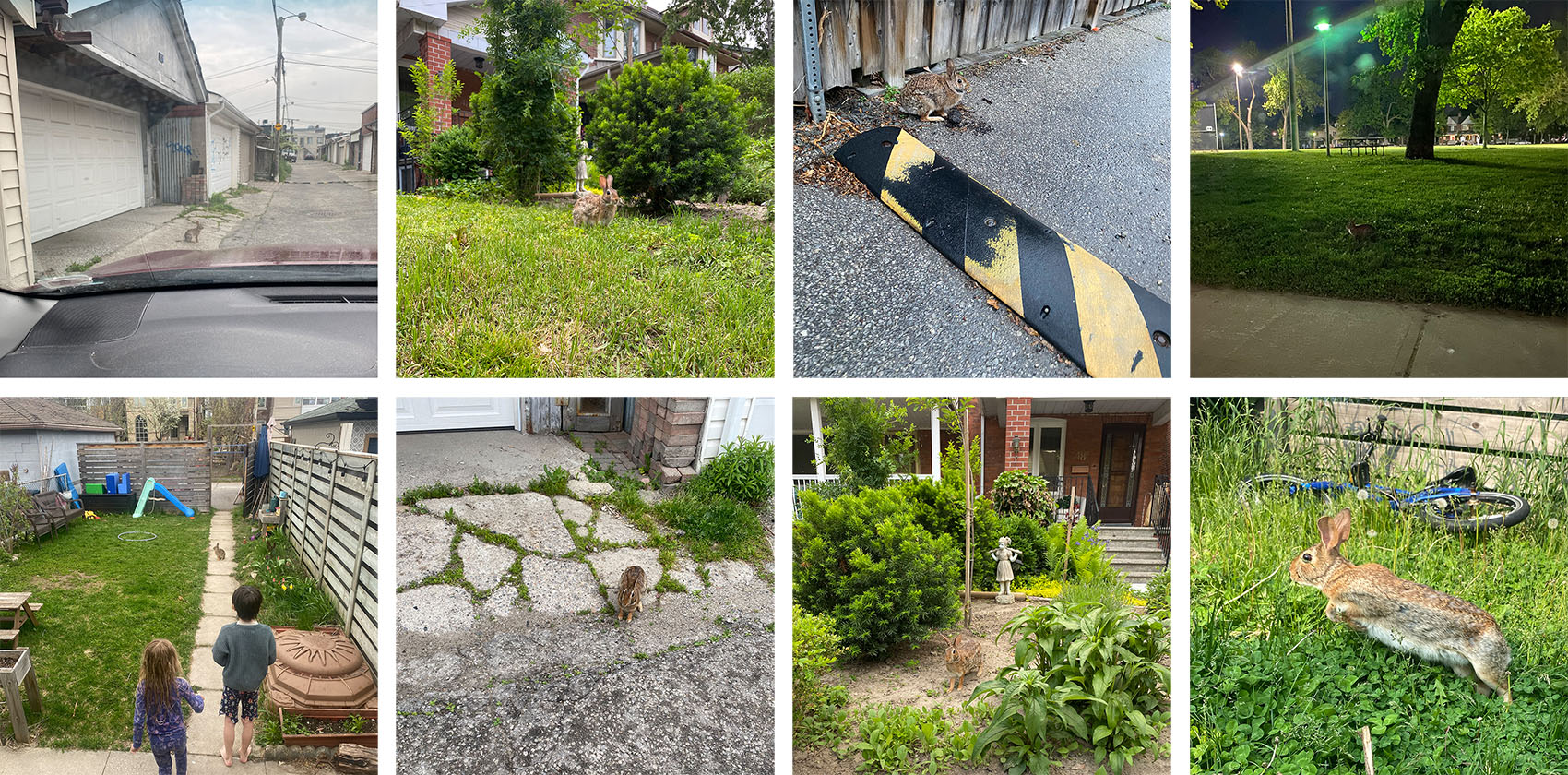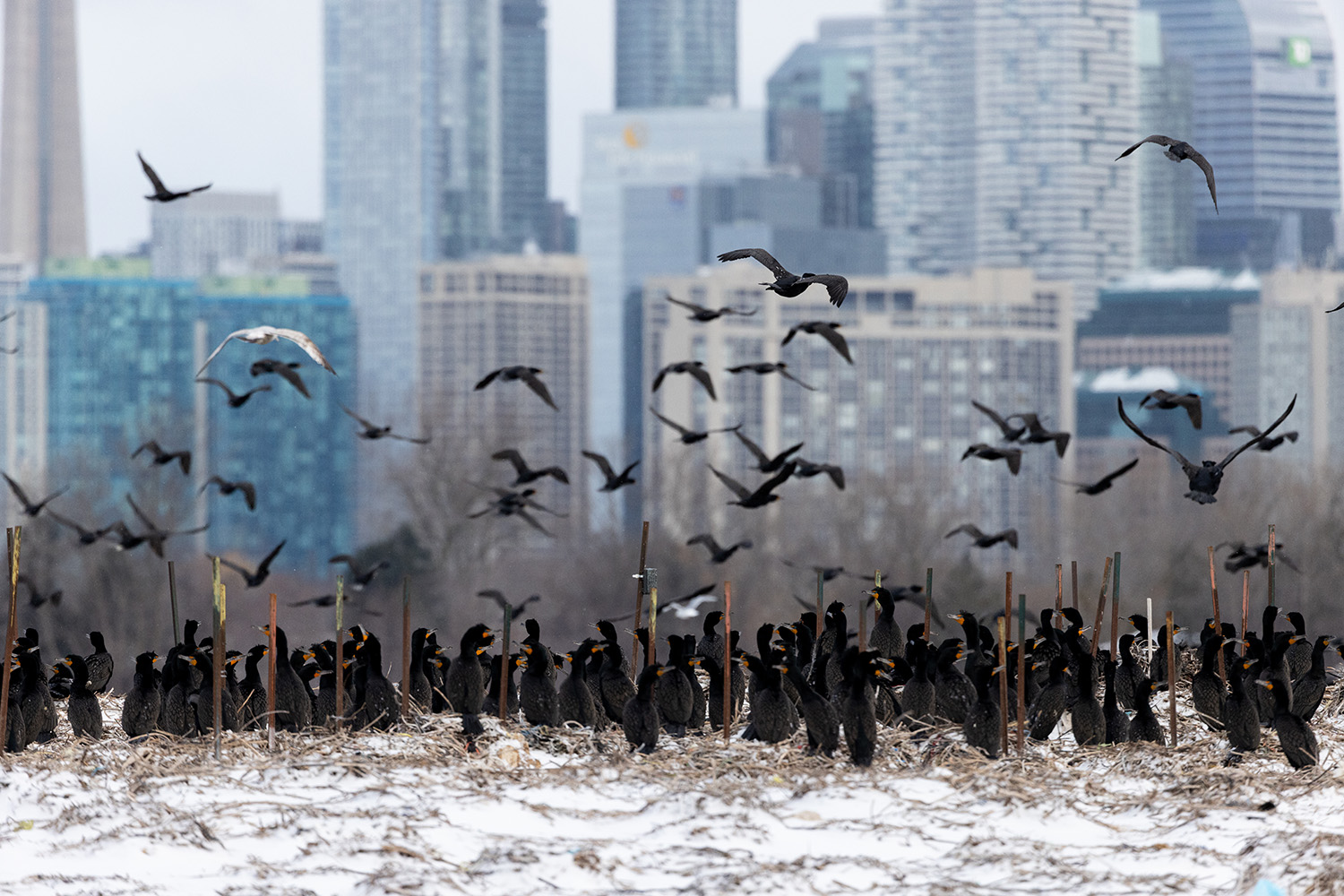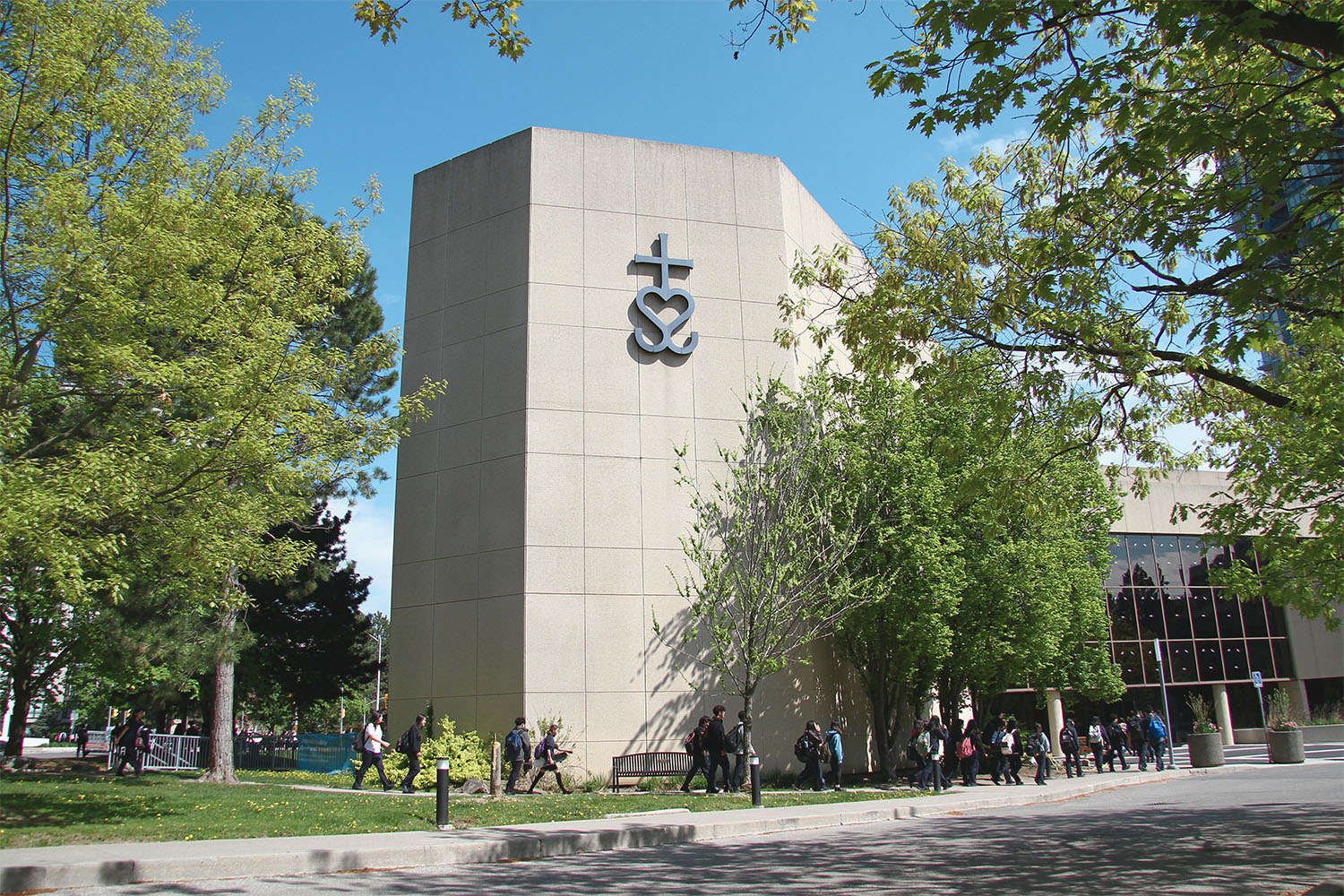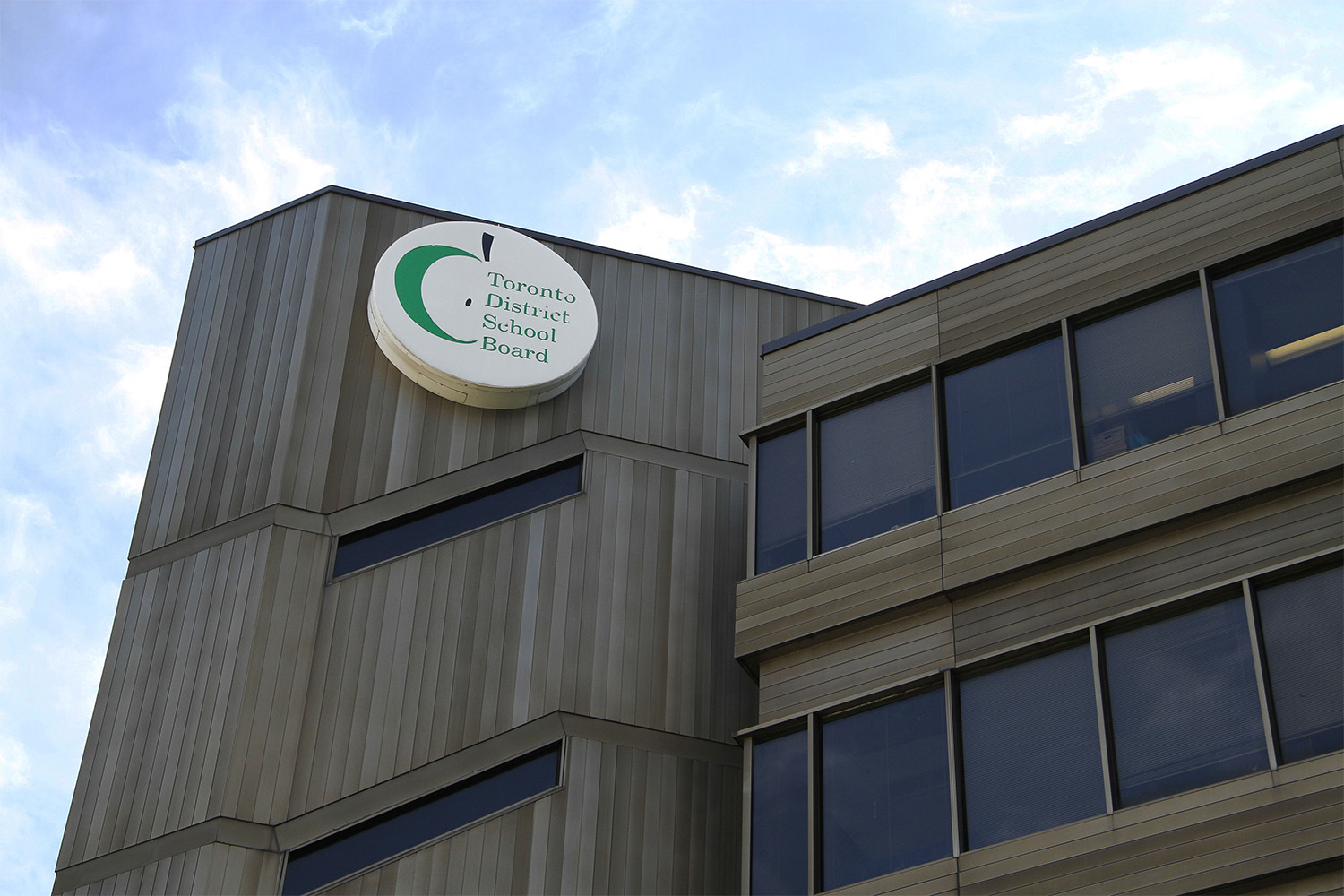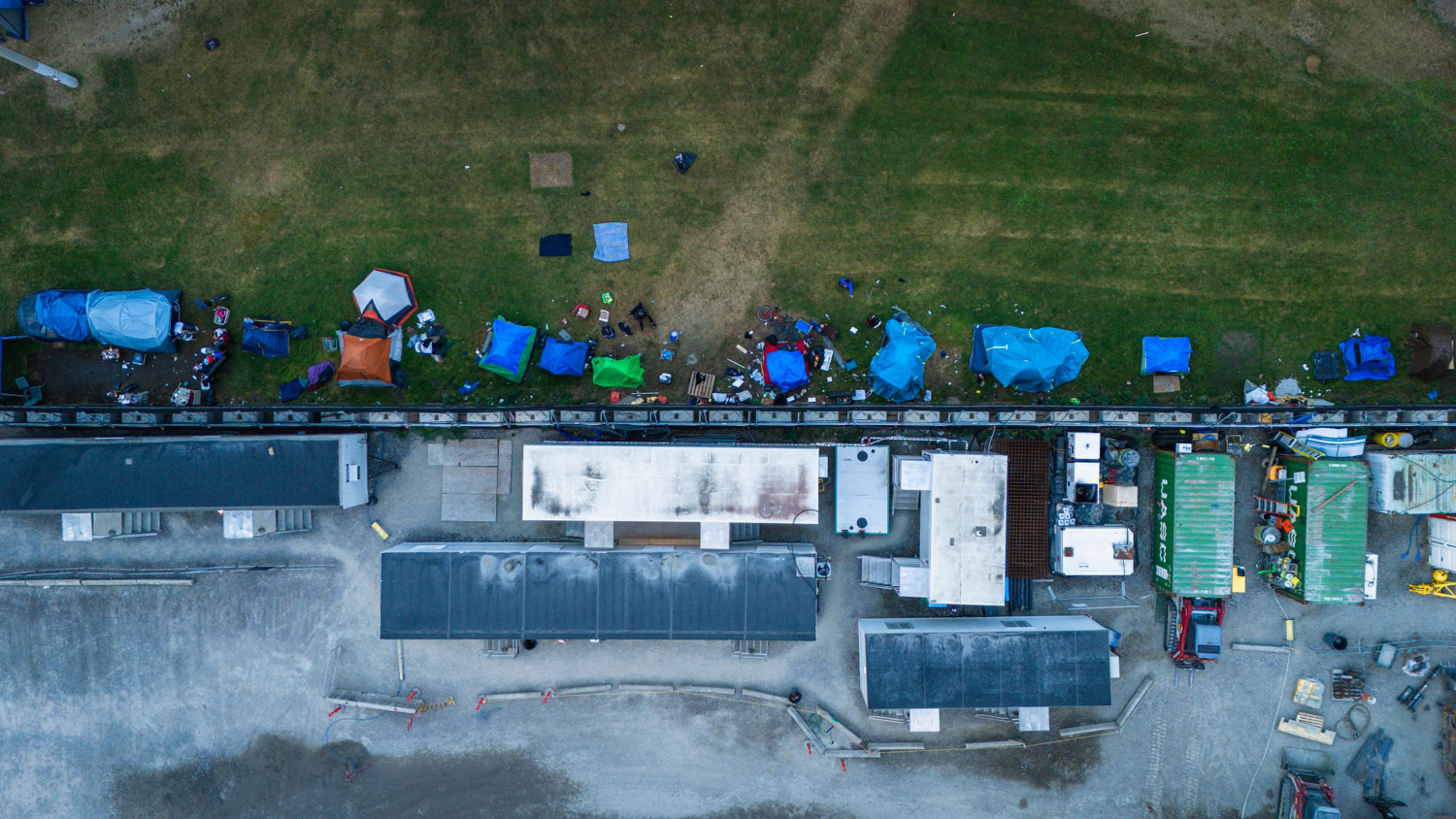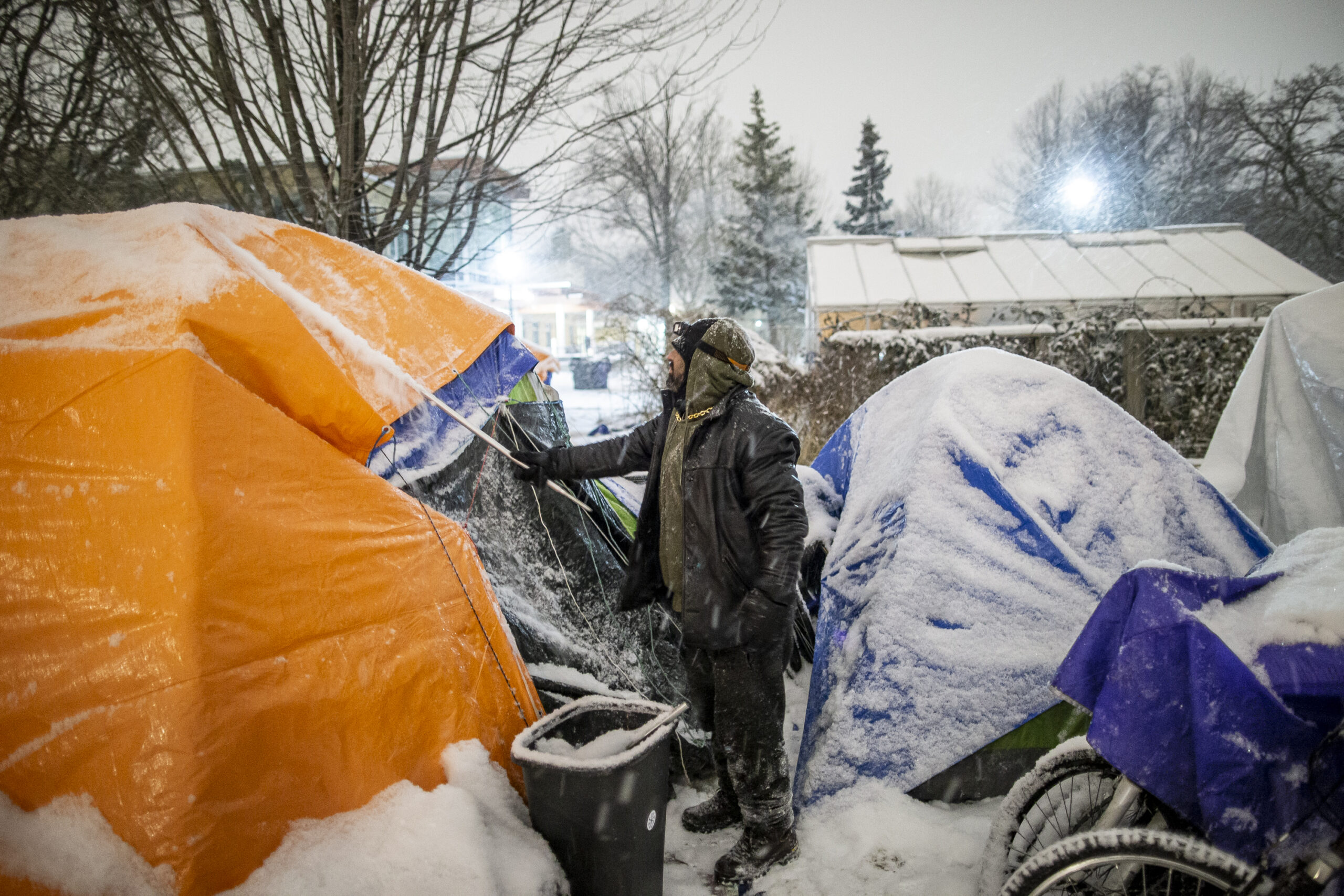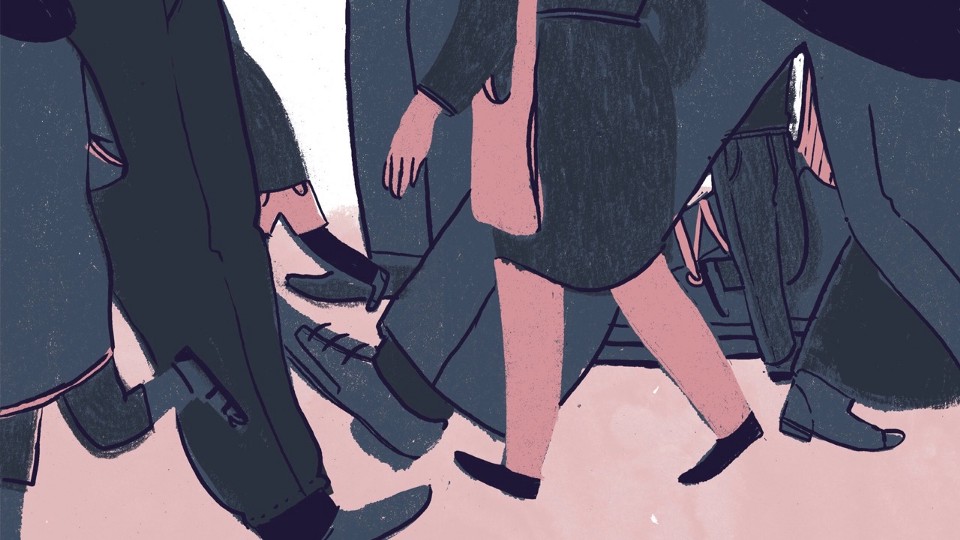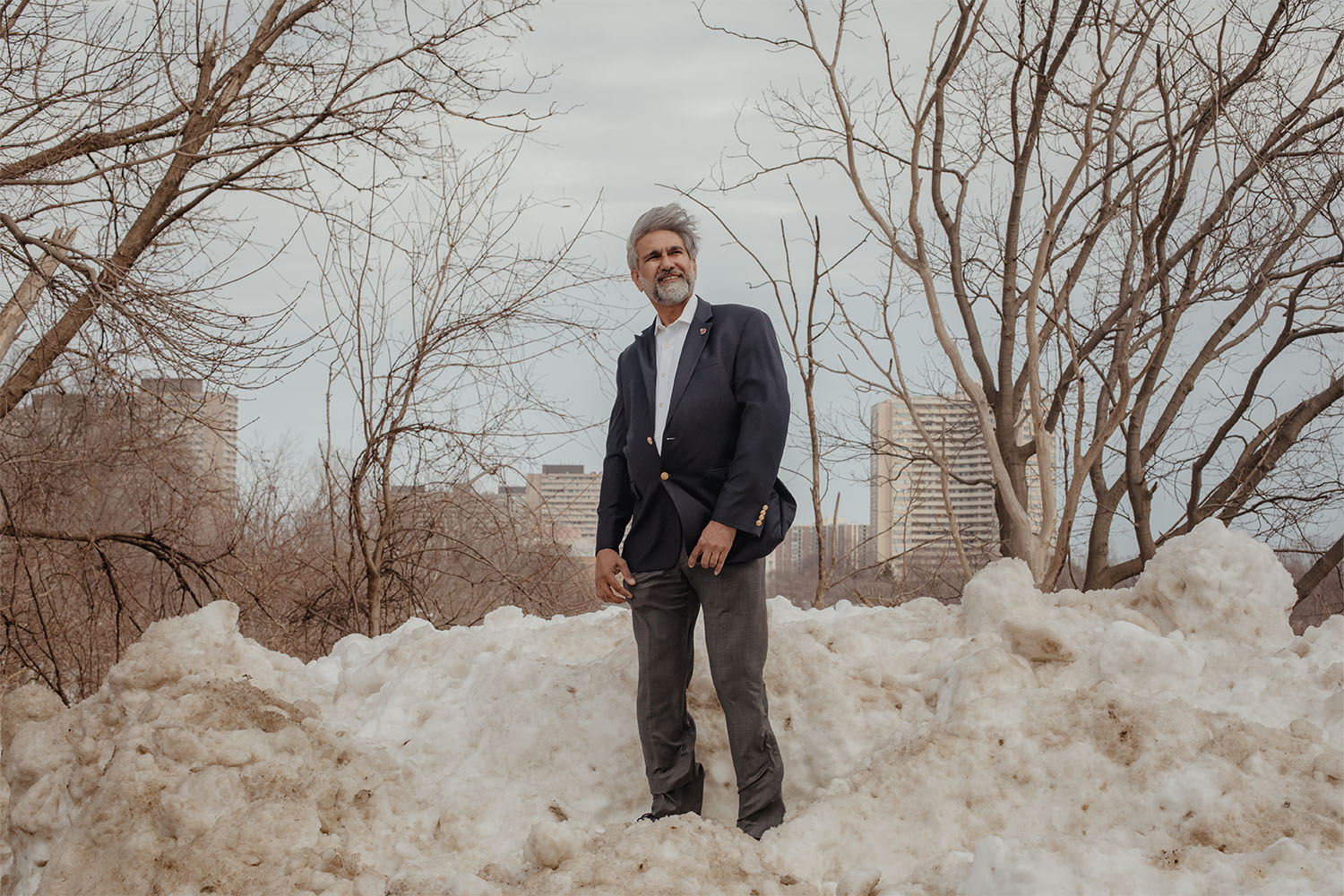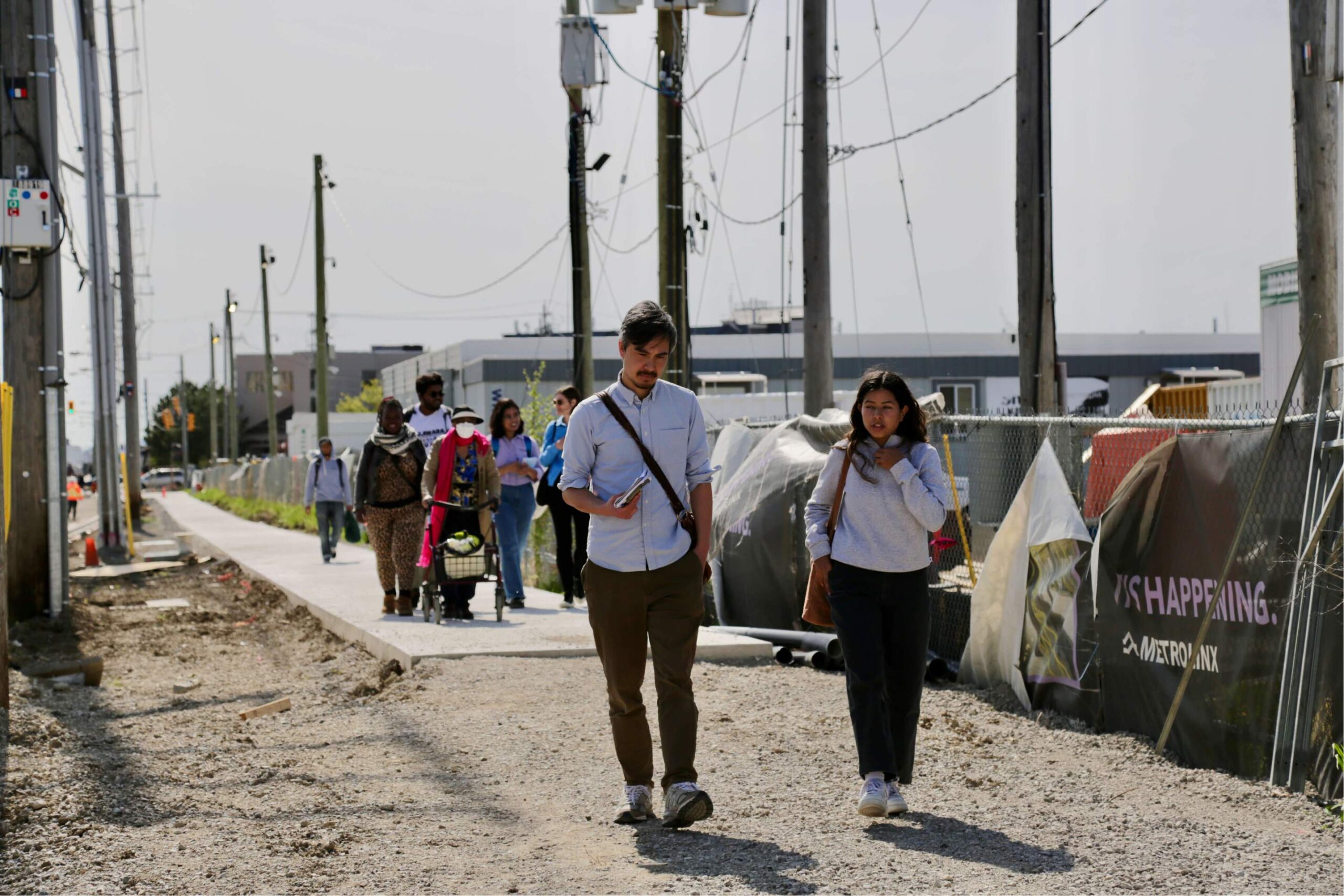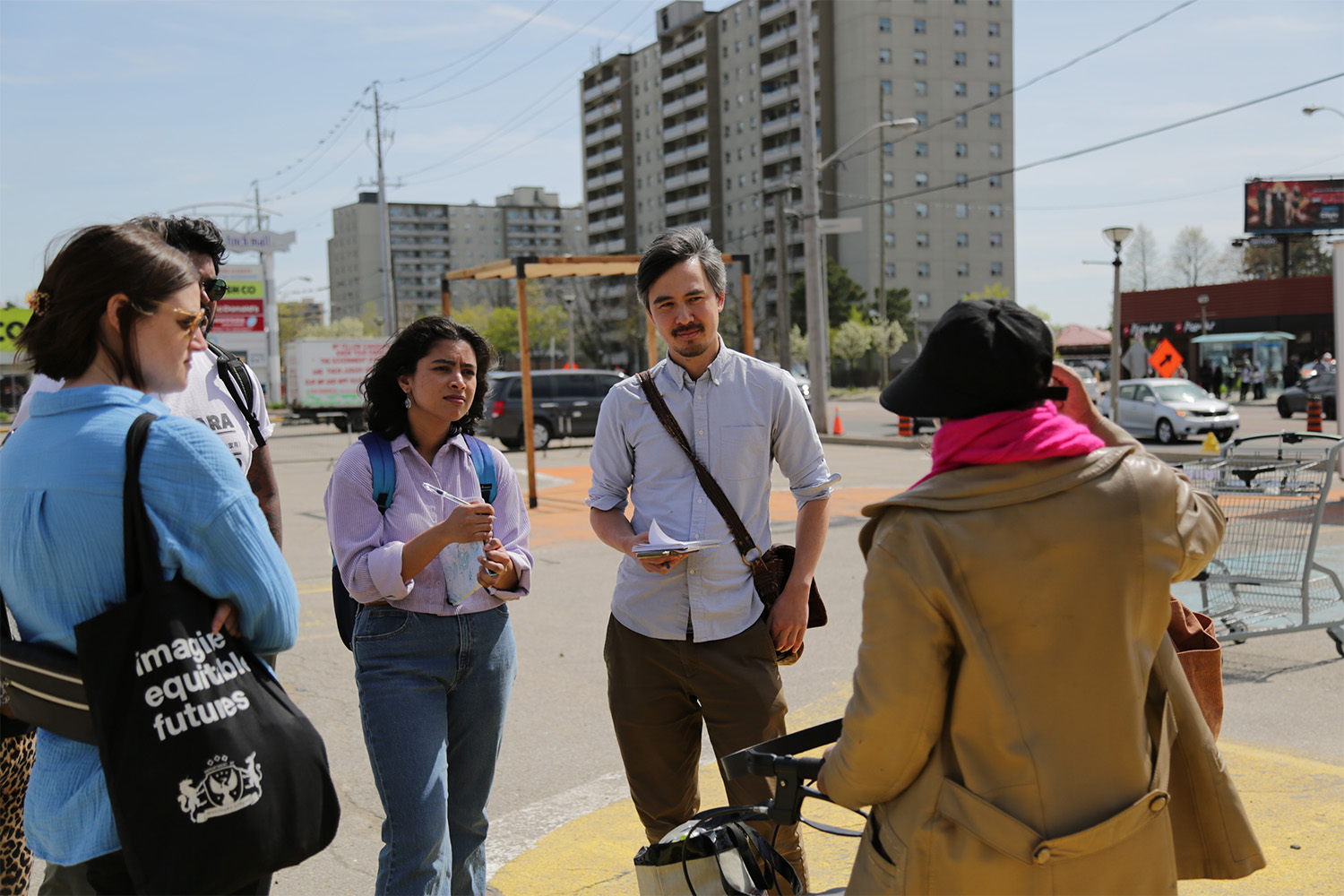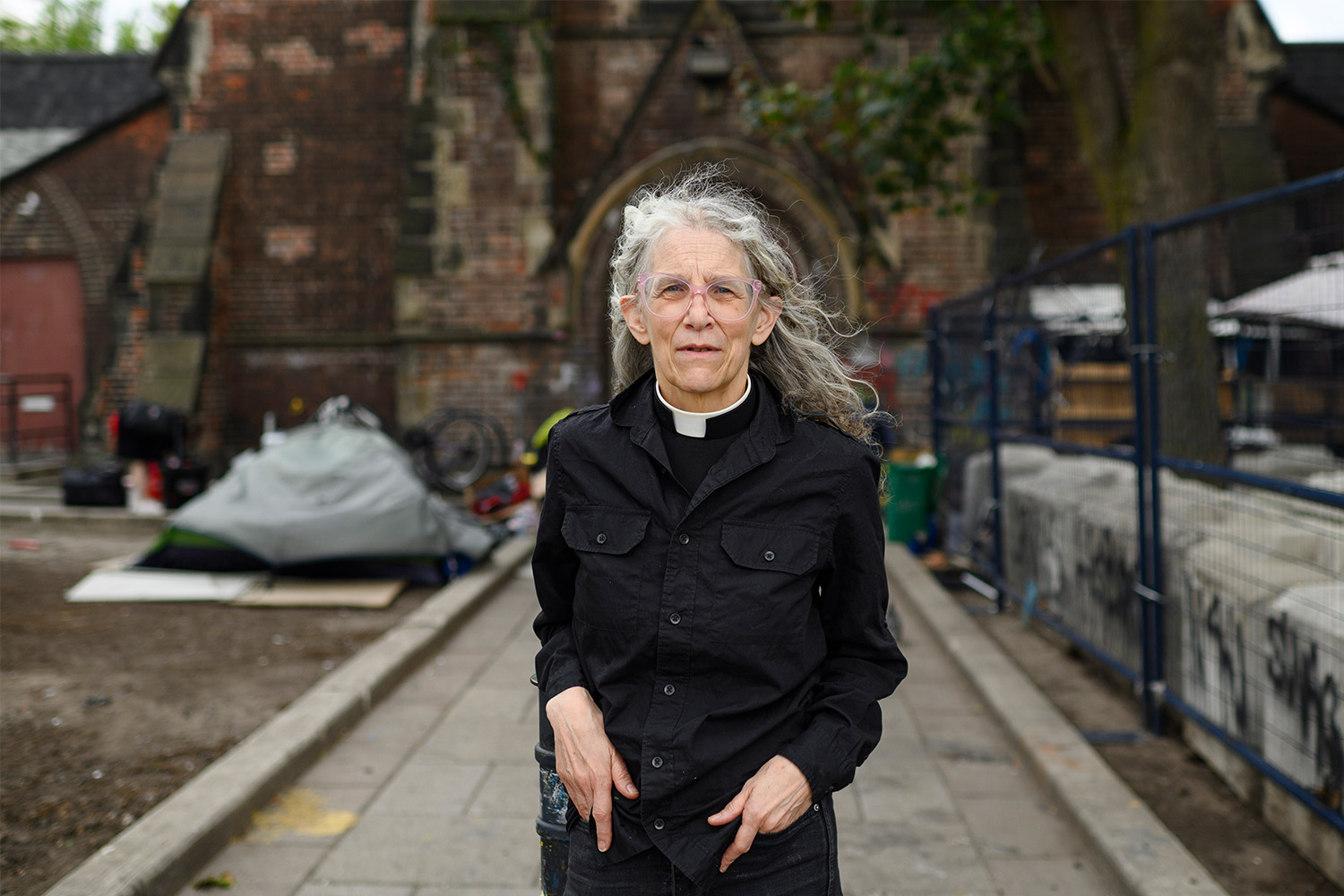

When Mother Maggie Helwig saw the number from the City of Toronto’s Encampment Office on the line, she knew trouble was coming. It was Oct. 19, 2023, and for the past year the reverend had been attending to the people living in the small encampment in the churchyard of St. Stephen-in-the-Fields, an Anglican parish perched on the edge of Kensington Market.
I had seen the evolution of the churchyard firsthand. My friends live in the apartment building adjacent to the church, and over the past few years I had been intermittently involved in efforts to support members of this encampment and others in Kensington Market. The churchyard’s population had ebbed and flowed, but it had always been present in some form. People wrapped themselves in blue tarps and sleeping bags in the shadow of the brick steeple. Lasting abodes of pallet and plywood were grafted onto the side of the church. Throughout it all, Helwig allowed people to stay, offering them food, water, and conversation.
In that time, Helwig said, “the city had been taking a fairly confrontational approach” to the encampment, “with notices and threats to evict.”
The local councillor, former environmental lawyer Dianne Saxe, was elected in 2022 after running a campaign focused on housing affordability and the environment. However, upon assuming office, her relationships with homeless advocates and community organizations like Friends of Kensington Market, a residents group that advocates for commercial and residential affordability, soured. “When it comes to unhoused people, it’s a wall,” says Serena Purdy, its chair. “It’s not an open conversation.”
For Saxe, the encampment at St. Stephen’s and other encampments in her ward deprive her constituents of crucial green space. “People need public parks for public use,” Saxe told me. “There shouldn’t be encampments in parks. Encampments are illegal…It badly degrades the city. It is one of the most visible symbols that the city is not looking after public space.”
Homeless advocates say it is precisely the visibility of encampments that incites clearances. “Dianne Saxe has tried a number of fairly dubious routes to see the encampment removed, or just invisibilized in some regard,” says outreach worker Diana Chan McNally. For Chan McNally, Saxe does so by “leveraging…environmentalism, which is the councillor’s background.”
Local Journalism Matters.
We're able to produce impactful, award-winning journalism thanks to the generous support of readers. By supporting The Local, you're contributing to a new kind of journalism—in-depth, non-profit, from corners of Toronto too often overlooked.
SupportThat day in October, according to Helwig, the voice on the line explained that a permit had been issued to clear the churchyard so that a pollinator garden could be built in its stead. It was late October, hardly the time to sow milkweed or wild bergamot, and the wind had turned bitterly toward winter. The permit, the voice from the Encampment Office said, was issued to a group called Friends of Bellevue Parkette, a nonprofit incorporated just months before.
It is unclear with whom Friends of Bellevue Parkette was friendly; they had no visible public presence, no relationships with other community groups, and just a single named director, who was also the director of the Montessori school two doors down the street. The proposed garden was their first and only charitable venture. (Friends of Bellevue’s director did not respond to multiple email requests for comment.)
Nevertheless, the city planned to clear the space. The encampment would be emptied in a week, maybe sooner, said the voice, before hanging up. Helwig immediately retained lawyers.
Using a proposed garden as a legal lever to displace a vulnerable group of people was a striking event, but it was hardly exceptional. Over the past few years, in the midst of a housing crisis, the City of Toronto has regularly deployed green rhetoric to displace homeless people from public space in what Chan McNally has called “weaponized environmentalism.”
Through cordoning off large swaths of parkland for “grass remediation,” moving homeless people from the shade of public trees, or building gardens where encampments lie, the city has become adept at using environmental rhetoric to regulate public space. It’s a pervasive attitude across city divisions’ response to poverty in public space, a reaction to the appearance of poor people in parks and beyond. And it’s an appealing strategy for city employees, indignant community members, and local politicians who like to think of themselves as progressive neighbours. Through the rhetoric of preserving Toronto’s public green spaces, certain people are excluded from the benefits of public life, because that idea of pristine, sanctified parks is only made possible by their displacement.

Weaponized environmentalism is not restricted to proposed pollinator gardens. In Allan Gardens, for example, housing advocates say the Encampment Office has used proposed tree trimmings to confiscate tents and personal property. Saoirse is a member of Allan Gardens Community Aid Collective, an activist group whose coordinators are all formerly unhoused, who prefers to remain anonymous due to fear of police reprisal and risk to their shelter. They describe tree trimming in Allan Gardens as a continuous tactic of displacement. They note that falling tree branches present a real danger, but argue that the city uses the health of trees to flout the convention of giving reasonable notice before a homeless person’s belongings are moved or removed.
Saoirse recalls one occasion in May 2023 when the parks department and their tree-trimming boom truck arrived with the Encampment Office to trim multiple trees that had tents in their shade. That day, Saoirse says, “using the tree-trimming as an excuse, they stole and trashed seven tents,” but “they did not trim a single tree that day.” Video and photos obtained by The Local show belongings being loaded into the back of a pickup truck, protesters surrounding an Encampment Office employee, and Parks, Forestry, and Recreation employees gesturing toward a tree. (The City confirmed to The Local that no tree maintenance took place that day but said it was occasionally necessary to relocate homeless people for tree maintenance: “As needed, staff from the Encampment Office and outreach teams will collaborate with encampment occupants to facilitate relocation during these operations.”)
“It is entirely possible to be an environmentalist and have very little care or compassion for humans”
“Remediation” is perhaps the most effective lever the city uses to ensure that homeless people are not able to set up encampments in parks. In 2021, an encampment in George Hislop Park near Bloor and Yonge was cleared and fences were erected in the name of “sod and irrigation improvements.” But “the fences just never came down,” says Greg Cook, an outreach worker at Sanctuary, a charity and church next to the park. The space was fenced off for nearly three years before park renovations began. Nearby Norman Jewison Park faced the same fate in July 2024, when an encampment was cleared and the grassy area was immediately fenced off for remediation.
For Cook, clearances in the name of park remediation are linked to the larger trend of gentrification. “That language of remediation is frankly awful,” he says. “I’ve noticed that environmental reasons are used to displace poor people in neighbourhoods.” Improving parks and saving grass, Cook says, is the rationale, not the reason, for fencing. It serves the dual purpose of providing a retroactive justification for clearances while ensuring new encampments cannot crop up. In its internally circulated plan to clear Trinity Bellwoods Park in 2021 (obtained by housing activists through a Freedom of Information request and reviewed by The Local), the city stated that fencing would be used to demarcate “areas that occupants have property,” and used in order to prevent reentry both during and indefinitely after the clearance. Internally, the stated purpose of the fencing was to prevent another encampment. The public-facing explanation on the fences told a different story: “park remediation is underway.”
The City invokes “remediation” even when green spaces are destroyed. During the Trinity Bellwoods encampment clearance of 2021, a community garden of raspberry bushes and patches of mint run by local volunteers in the park’s southwest corner was razed due to its proximity to the encampment. According to the community group that ran the garden, a city official, in the midst of the Trinity Bellwoods clearances, had implied that some illicit items might have been stashed in the garden. When the fences went up, they bore a familiar sign: “park remediation is underway.” When a pollinator garden was real rather than rhetorical, it was promptly bulldozed.

The use of this ecological rhetoric, says Chan McNally, is “a way of greenwashing people’s hatred.” Park remediation, she says, is effective as a displacement strategy because it hinges on the dehumanization of those who have been cleared so that it can take place. “If you can’t recognize homeless people as people then you’re never going to consider them worthy of being a part of the public, but rather a safety concern, a blight,” she says. “They use all this weird environmentalist doublespeak for nefarious purposes.”
Concerning its remediation policy, the City of Toronto stated: “As individuals are referred indoors and encampments are cleared, staff work to regenerate parks. This may include the removal of fine debris and hazards, removal and aeration of soil/sand, weekly applications of seed and fertiliser, pest removal, tree inspection and/or planting.”
After the call from the Encampment Office, the controversy at St. Stephen’s only deepened. The permit, Helwig learned, was not explicitly for a garden, but was instead a street occupancy permit granted by the Transportation Division (a copy of the permit was obtained through a Freedom of Information Request request made by Helwig). However, just days after the permit was issued to Friends of Bellevue Parkette, it was revoked. The city said that the permit was issued “in error,” but that they still planned to clear the encampment. Trying to prevent the eviction, St. Stephen’s church filed an interlocutory injunction in the Ontario Superior Court of Justice. (The city told The Local that no permit was necessary to clear the encampment because of the churchyard’s technical status as a city right-of-way. It’s unclear why the city worked with Friends of Bellevue Parkette to clear the encampment with the support of a permit it did not legally require.)
In late November 2023, a month after Reverend Helwig’s call from the Encampment Office, the eviction took place at St. Stephen’s. Helwig’s injunction had failed to convince the judge, who cited fire safety and aesthetic concerns in his decision. The city’s grounds to evict lay in two provisions of a street obstruction bylaw. The residents of St Stephen’s had been offered indeterminate stays at a shelter, though some had refused this offer precisely because of a shelter’s indeterminacy. Talk of a pollinator garden had evaporated, but agents of the city still arrived and the claw arrived with them.
It was a long and bitter night. Encampment residents negotiated with the city, to little avail, while neighbours, members of the church, and legal observers, gathered to protest and witness the eviction. Ultimately, in the hours before dawn, the encampment’s final tents and belongings were removed. The city’s familiar blue fences were then erected on the south side of the churchyard. Personal belongings were strewn along the sidewalk, spilling out into College Street.

Arturo Garcia saw it all. A longtime resident of St. Stephen’s yard, his belongings were the only ones spared bulldozing because his small abode leans against the western wall of the parish and is indisputably on church grounds. So he watched, he said, and he tried to help, as those who slept just a few feet closer to the street were upended.
Garcia, who is 52, is also known as “Pirate” on account of his eccentricity and eyepatch-style single sunglass. He explained that the night the city came to clear the encampment, the folks who were relocated by the city were not long-term residents of the encampment, but transient ones. According to Garcia, no permanent or semi-permanent residents of the encampment were relocated that night. “They misled everyone intentionally. They were all proud of themselves…but the people who they set up with a place to live didn’t live here. Nobody from here got housing.” Garcia explained that the city betrayed an ignorance, despite their repeated engagements, of who was transient and who had set up more permanent lodging under the shadow of St. Stephen’s steeple.
Three days later, the concrete came—enormous blocks set in place to prevent any future tents. An eviction whose inciting event was a proposed pollinator garden culminated in the loud crunch of concrete blocks being lowered, one by one, onto the frosted soil in the newly fenced-off area.
On a balmy July day, I waited on the steps of St. Stephen-in-the-Fields for Reverend Helwig. People had slowly returned to the encampment after the last clearance, and a few interwoven tarps and tents fluttered loudly in the wind. The cement blocks were still there, 4,200 pounds each, surrounding a sullen Norwegian maple and almost certainly causing soil compaction. The blocks’ proximity to the tree contravene the city’s own policy surrounding tree protection, adding fuel to protestors claims that the city was enforcing its rules unevenly.
“Okay, so this is your fantastic pollinator garden,” Helwig said. “A bunch of concrete blocks that are killing the tree.” After the blocks were placed there, Helwig explained, encampment supporters started calling Parks, Forestry, and Recreation. “So then, the next day, they came back and removed some of the concrete blocks.” Throughout the excruciating month-long struggle to prevent the eviction, the city had negotiated with a stone face, making no concessions, hardly communicating, denying any wrongdoing. No appeal to human rights was successful—but an appeal to soil compaction was. To Helwig’s frustration, the levers of municipal power were moved not through direct engagement with affected human subjects, but with the ecology that surrounds them.
Reverend Helwig’s frustration lies largely with Councillor Saxe. “It is entirely possible to be an environmentalist and have very little care or compassion for humans,” says Helwig. “It appears she’s one of that sort of environmentalist, which is too bad.”
Saxe takes a different view. “They asked me for six month’s patience and six months later, the church had not taken responsibility for the tents, or the people, or the trash—they take no responsibility for the encampment that they have allowed to occur on public property.” She elaborated on the reasons she wants the encampment cleared. “It’s one door up from the school, and the children in the schoolyard. There’s been aggressive masturbation by people from the encampment against the children. There’s crack pipes. In the schoolyard, there’s used condoms and drug paraphernalia. Teachers have been chased inside, parents have been screamed at. And of course also the fire risk.” Saxe’s attribution of these acts to residents of the encampment could not be verified.
“There is a tremendous amount of deprivation and desperation in this neighbourhood,” Helwig acknowledges. “It’s very distressing for all of us, but it is not going to be fixed by displacing a handful of people in tents.”
Saxe says that she was not actively involved in the plan for the community garden, but that she knew about the plan and thought it was a good idea. However, the City of Toronto told The Local: “We’d suggest you could contact the local councillor as she was engaged in the conversation between the church and the City that led to the notion of one possible use of the space including a garden.” Saxe has other ideas for the churchyard, too, including converting it into a homeless memorial.

For Helwig and Arturo Garcia, however, that patch of ground is already a memorial. Almost immediately after the encampment was first cleared, people breached the fencing and returned to the churchyard. “Obviously, if there’s a fence, people are gonna hang things on the fence. It creates areas of less visibility, areas of less traffic,” says Helwig. “And that’s where danger happens. We’ve had two fatal overdoses here since the attempt to clear as opposed to zero previous to that. Because it’s been made a less visible, less accessible area. That fence is a safety hazard.” (The City told The Local that the fence was installed to mitigate health and safety risks and “has bars, which allows continued sight lines from side to side.” They also said they were “aware that the fence has been breached and are discussing plans to remove it.”)
Garcia gestures toward the concrete blocks and starts listing people who have lived here and people who have died, recalling their personalities, and recounting their fates. We circle the fence. Clothes hang from it, plywood is piled in one corner atop the concrete. “They don’t care, they want us dead,” he says. “They want to get rid of the riffraff.”
I ask Maggie Helwig about the apparent contradiction of this eviction and actions like it, where ecology is used as a pretext for removing people from public space. She tilts her head back to look at me. “Of course people care more about trees than about people. Of course they do. I mean, trees don’t give you any trouble. Trees don’t have complex needs. Trees don’t have PTSD. Or if they do, they’re very quiet about it.”
In early August, the city once again cleared what tents and pallets they could from the churchyard. Only Garcia is still there; the city took the door of his makeshift home but spared the rest. Once again, the churchyard is barren but for the Norwegian maple, still engulfed in concrete and leaning precipitously over the sidewalk. Recently, one limb has been haphazardly shorn, leaving a sappy wound where a branch once grew. It looks sickly. The maple may not cause trouble, but it has witnessed its share of death and displacement. It will likely witness more. As I watch, it seems to creak in the wind.
